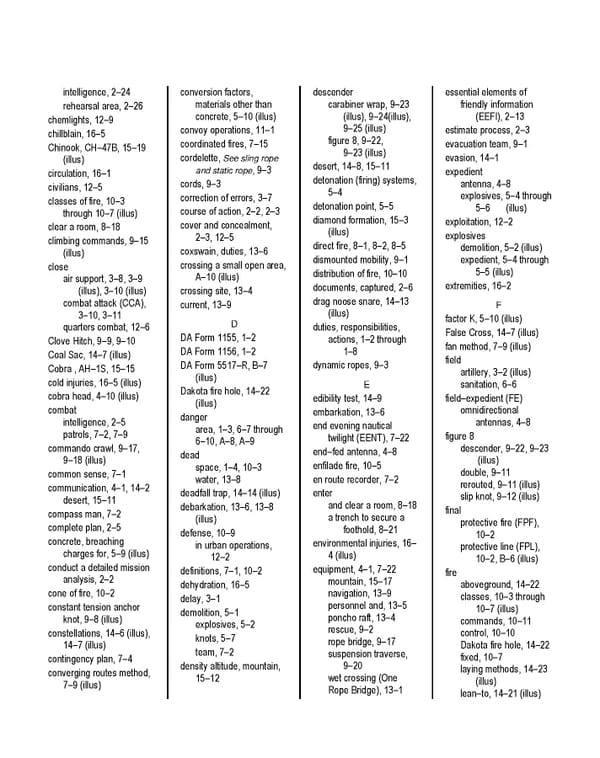intelligence, 2–24 rehearsal area, 2–26 chemlights, 12–9 chillblain, 16–5 Chinook, CH–47B, 15–19 (illus) circulation, 16–1 civilians, 12–5 classes of fire, 10–3 through 10–7 (illus) clear a room, 8–18 climbing commands, 9–15 (illus) close air support, 3–8, 3–9 (illus), 3–10 (illus) combat attack (CCA), 3–10, 3–11 quarters combat, 12–6 Clove Hitch, 9–9, 9–10 Coal Sac, 14–7 (illus) Cobra , AH–1S, 15–15 cold injuries, 16–5 (illus) cobra head, 4–10 (illus) combat intelligence, 2–5 patrols, 7–2, 7–9 commando crawl, 9–17, 9–18 (illus) common sense, 7–1 communication, 4–1, 14–2 desert, 15–11 compass man, 7–2 complete plan, 2–5 concrete, breaching charges for, 5–9 (illus) conduct a detailed mission analysis, 2–2 cone of fire, 10–2 constant tension anchor knot, 9–8 (illus) constellations, 14–6 (illus), 14–7 (illus) contingency plan, 7–4 converging routes method, 7–9 (illus) conversion factors, materials other than concrete, 5–10 (illus) convoy operations, 11–1 coordinated fires, 7–15 cordelette, See sling rope and static rope, 9–3 cords, 9–3 correction of errors, 3–7 course of action, 2–2, 2–3 cover and concealment, 2–3, 12–5 coxswain, duties, 13–6 crossing a small open area, A–10 (illus) crossing site, 13–4 current, 13–9 D DA Form 1155, 1–2 DA Form 1156, 1–2 DA Form 5517–R, B–7 (illus) Dakota fire hole, 14–22 (illus) danger area, 1–3, 6–7 through 6–10, A–8, A–9 dead space, 1–4, 10–3 water, 13–8 deadfall trap, 14–14 (illus) debarkation, 13–6, 13–8 (illus) defense, 10–9 in urban operations, 12–2 definitions, 7–1, 10–2 dehydration, 16–5 delay, 3–1 demolition, 5–1 explosives, 5–2 knots, 5–7 team, 7–2 density altitude, mountain, 15–12 descender carabiner wrap, 9–23 (illus), 9–24(illus), 9–25 (illus) figure 8, 9–22, 9–23 (illus) desert, 14–8, 15–11 detonation (firing) systems, 5–4 detonation point, 5–5 diamond formation, 15–3 (illus) direct fire, 8–1, 8–2, 8–5 dismounted mobility, 9–1 distribution of fire, 10–10 documents, captured, 2–6 drag noose snare, 14–13 (illus) duties, responsibilities, actions, 1–2 through 1–8 dynamic ropes, 9–3 E edibility test, 14–9 embarkation, 13–6 end evening nautical twilight (EENT), 7–22 end–fed antenna, 4–8 enfilade fire, 10–5 en route recorder, 7–2 enter and clear a room, 8–18 a trench to secure a foothold, 8–21 environmental injuries, 16– 4 (illus) equipment, 4–1, 7–22 mountain, 15–17 navigation, 13–9 personnel and, 13–5 poncho raft, 13–4 rescue, 9–2 rope bridge, 9–17 suspension traverse, 9–20 wet crossing (One Rope Bridge), 13–1 essential elements of friendly information (EEFI), 2–13 estimate process, 2–3 evacuation team, 9–1 evasion, 14–1 expedient antenna, 4–8 explosives, 5–4 through 5–6 (illus) exploitation, 12–2 explosives demolition, 5–2 (illus) expedient, 5–4 through 5–5 (illus) extremities, 16–2 F factor K, 5–10 (illus) False Cross, 14–7 (illus) fan method, 7–9 (illus) field artillery, 3–2 (illus) sanitation, 6–6 field–expedient (FE) omnidirectional antennas, 4–8 figure 8 descender, 9–22, 9–23 (illus) double, 9–11 rerouted, 9–11 (illus) slip knot, 9–12 (illus) final protective fire (FPF), 10–2 protective line (FPL), 10–2, B–6 (illus) fire aboveground, 14–22 classes, 10–3 through 10–7 (illus) commands, 10–11 control, 10–10 Dakota fire hole, 14–22 fixed, 10–7 laying methods, 14–23 (illus) lean–to, 14–21 (illus)
 Ranger Handbook Page 347 Page 349
Ranger Handbook Page 347 Page 349